#historical women in power
Text
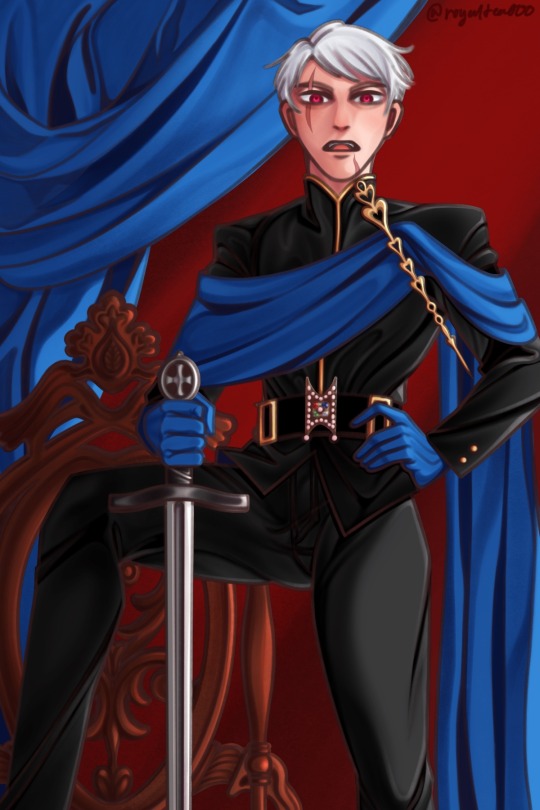
drawing him completely clothed as repentance for drawing him completely nude
#sorry women#😔#attempting another military portrait thing#but what the fuck is going on with my rendering#[stares at hands like I’ve just lost my power]#completely covered has its own appeal 😏#I can’t decide if I actually hate or like this#digital art#my art#commissions open#artists on tumblr#procreate#digital illustration#illustration#digital painting#fanart#hetalia#historical hetalia#hws prussia#hetalia fanart#aph prussia#gilbert beilschmidt#off with their heads ass pose#I actually did reference the queen of hearts from the live action Alice in wonderland movie for this lmfao#IT WAS THE BEST REFERENCE FOR WHAT I HAD IN MIND OKAY#bussin it wide open for the lads#alpha spreading
168 notes
·
View notes
Text

Japan's third empress regnant, Empress Jitō (645-703) was a powerful and effective ruler. Shrewd, bold and clever, she walked in the footsteps of empresses Suiko and Saimei and prevailed against all odds.
A troubled youth
Jitō was the daughter of Prince Naka no Ōe, the son of empress regnant Saimei. The year she was born, her father killed a minister in front of his mother, leading to her abdication.
Jitō’s maternal grandfather committed suicide three years later, having been wrongly accused of plotting against Prince Naka no Ōe. Jitō’s mother, Ochi, died of grief. Jitō was thus placed in her grandmother's care and raised by the former empress.
At age 12, she was married to her paternal uncle, Prince Ōama, who was 27. Jitō was a reserved person with a brilliant intelligence and much liked by the court. She was curious, open-minded and studied Chinese literature. The death of her grandmother in 661 pained her greatly. In 662, Jitō gave birth to her only child: prince Kusakabe. Her father then ascended took the throne as Emperor Tenji in 667.
Succession struggle
The question of Emperor Tenji’s succession soon arose. The sovereign favored Jitō’s half-brother, Prince Ōtomo, but Prince Ōama had his own ambitions. He and Jitō left the court, waiting for an opportunity to strike.
Ōtomo indeed succeeded Tenji, but Ōama revolted against him soon after with Jitō's support. When they arrived at Ise province, she dressed in male clothes and personally addressed the troops. She also worked on tactical plans. As Ōama left to leave an offensive in Ōmi province, Jitō took command of the troops stationed at Ise. She had indeed volunteered to defend the shrine dedicated to the sun Goddess, Amaterasu.
Their joint efforts led to their success. Ōama ascended the throne in 673 as emperor Tenmu, with Jitō becoming his co-ruler.
The radiant empress
Jitō was very influential in court matters. This was reflected in the choice of Tenmu's heir. He could have chosen his son by another woman, Prince Ōtsu, as his heir, but chose Jitō’s son, Prince Kusakabe, instead.
As Tenmu died in 686, Jitō took the matter in hand. She declared Ōtsu guilty of treason and forced him to commit suicide. She then organized grandiose funerals for her husband and wrote poems expressing her grief.
Oh, the autumn foliage
Of the hill of Kamioka!
My good Lord and Sovereign
Would see it in the evening
And ask of it in the morning.
On that very hill from afar
I gaze, wondering
If he sees it to-day,
Or asks of it to-morrow.
Sadness I feel at eve,
And heart-rending grief at morn—
The sleeves of my coarse-cloth robe
Are never for a moment dry.
Her son died in 689. Since her grandson was too young to rule, Jitō became empress regnant.
She reformed the country, establishing a strong central power and surrounded herself with capable ministers. In 689, she enacted a mandatory code for all local governors. In 690, she launched a population census.
She reformed the army, improving the recruitment conditions and the troops' training. A protector of the arts, she also actively participated in the propagation of Buddhism. Poetry became more refined during her reign. One of her poems was later included in the popular Hyakunin Isshu anthology:
The spring has passed
And the summer come again
For the silk-white robes
So they say, are spread to dry
On Mount Kaguyama
Jitō made her predecessors' objective of replacing the tribal system with a strong central power a reality. Her rule was synonymous with a degree of stability that neither her father nor husband were able to reach. She can be regarded as one of the true founders of Japan’s imperial monarchy. The empress was also fond of travels. In 692, she undertook a trip symbolic trip to Ise province, strengthening her authority and gaining the support of the local people.
The empress indeed took advantage of the Shinto rituals and the image of the sun Goddess to reinforce her legitimacy and used the links between the deity and the imperial family. Such was her prestige that Kakinomoto no Hitomaro, one of the greatest poets of his time, compared her to a goddess.
The retired empress
Jitō’s grandson, Monmu (r. 697-707) was ready to take the throne. She stepped back as Dajō Tennō (or “retired emperor”), becoming the first sovereign in Japanese history to assume this title. The power was in reality still in her hands. The Taihō Code was promulgated in 701, reforming governmental administration as well as administrative and penal law. This was only made possible by the reforms enacted during her reign.
In 702, she went through another tour of inspection of the eastern provinces and bestowed gifts and court ranks on the local officials and leading farmers. Jitō died in the first month 703 and her ashes were interred in her husband's tomb.
Here's is the link to my Ko-Fi if you like what I do! Your support would be greatly appreciated.
Further reading:
Aoki Michiko Y., "Jitō Tennō, the female sovereign",in: Mulhern Chieko Irie (ed.), Heroic with grace legendary women of Japan
Souyri Pierre-François, Nouvelle histoire du japon
#history#women in history#women's history#women's history month#japan#japanese history#powerful women#herstory#historyedit#7th century#queens#historyblr#historical figures#japanese prints#japanese art
121 notes
·
View notes
Text

The feminine urge to program computers and write algorithms!
👩🏻💻💜👩🏾💻
#history#ada lovelace#computer programming#women in stem#computer#womens history#england#ai#technology#historical figures#computer history#victorian age#just girly things#femininity#london#soft girl#girl power#english history#women empowerment#historical women#girly things#girl thoughts#role model#artificial intelligence#girlboss#technology history#algorithm#nickys facts
209 notes
·
View notes
Text
Hello ranger’s apprentice fandom can we talk real quick about the stupidest thing Flanagan ever wrote
It’s about the bows. Yanno, the rangers’ Iconique™️ main weapon. That one. You know the one.
Flanagan. Flanagan why are your rangers using longbows.
“uh well recurve arrows drop faster” BUT DO THEY. FLANAGAN. DO THEY.
the answer is no they don’t. Compared to a MODERN, COMPOUND (aka cheating) bow, yes, but compared to a longbow? Y’know, what the rangers use in canon? Yeah no a recurve actually has a FLATTER trajectory. It drops LATER.
This from an article comparing the two:
“Both a longbow and a recurve bow, when equipped with the right arrow and broadhead combination, are capable of taking down big game animals. Afterall, hunters have been doing it for centuries with both types of bows.
However, generally speaking and all things equal, a recurve bow will offer more arrow speed, creating a flatter flight trajectory and retain more kinetic energy at impact.
The archers draw length, along with the weight of the arrow also affect speed and kinetic energy. However, the curved design of the limbs on a recurve adds to its output of force.”
It doesn’t actually mention ANY distance in range! And this is from a resource for bow hunting, which, presumably, WOULD CARE ABOUT THAT SORT OF THING!
Okay so that’s just. That’s just the first thing.
The MAIN thing is that even accounting for “hur dur recurves drop faster” LONGBOWS ARE STILL THE STUPID OPTION.
Longbows, particularly and especially ENGLISH longbows, are—as their name suggests—very long. English longbows in particular are often as tall or taller than their wielder even while strung, but especially when unstrung. An unstrung longbow is a very long and expensive stick, one that will GLADLY entangle itself in nearby trees, other people’s clothes, and any doorway you’re passing through.
And yes, there are shorter longbows, but at that point if you’re shortening your longbow, just get a goddamn recurve. And Flanagan makes a point to compare his rangers’ bows to the Very Long English Longbow.
Oh, do you know how the Very Long English Longbow was mostly historically militarily used? BY ON-FOOT ARCHER UNITS. Do you know what they’re TERRIBLE for? MOUNTED ARCHERY.
Trust me. Go look up right now “mounted archery longbow.” You’ll find MAYBE one or two pictures of some guy on a horse struggling with a big stick; mostly you will actually see either mounted archers with RECURVES, or comparisons of Roman longbow archers to Mongolian horse archers (which are neat, can’t lie, I love comparing archery styles like that).
Anyway. Why are longbows terrible for mounted archery? Because they’re so damn long. Think about it: imagine you’re on a horse. You’re straddling a beast that can think for itself and moves at your command, but ultimately independently of you; if you’re both well-trained enough, you’re barely paying attention to your horse except to give it commands. And you have a bow in your hands. If your target is close enough to you that you know, from years of shooting experience, you will need to actually angle your bow down to hit it because of your equine height advantage, guess what? If you have a longbow, YOU CAN’T! YOUR HORSE IS IN THE WAY BECAUSE YOUR BOW IS TOO LONG! Worse, it’s probably going to get in the general area of your horse’s shoulder or legs, aka moving parts, which WILL injure your horse AND your bow and leave you fresh out of both a getaway vehicle and a ranged weapon. It’s stupid. Don’t do it.
A recurve, on the other hand, is short. It was literally made for horse archers. You have SO much range of motion with a recurve on horseback; and if you’re REALLY good, you know how to give yourself even more, with techniques like Jamarkee, a Turkish technique where you LITERALLY CAN AIM BACKWARDS.
For your viewing enjoyment, Serena Lynn of Texas demonstrating Jamarkee:
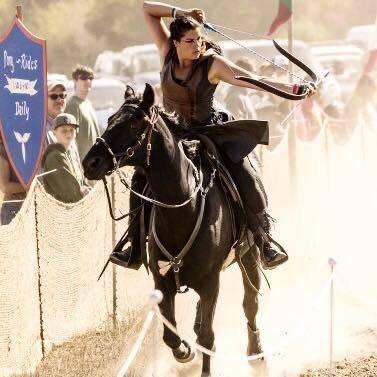
Yes, that’s real! This type of draw style is INCREDIBLY versatile: you can shoot backwards on horseback, straight down from a parapet or sally port without exposing yourself as a target, or from low to the ground to keep stealthy without banging your bow against the ground. And, while I’m sure you could attempt it with a longbow, I wouldn’t recommend it: a recurve’s smaller size makes it far more maneuverable up and over your head to actually get it into position for a Jamarkee shot.
A recurve just makes so much more SENSE. It’s not a baby bow! It’s not the longbow’s lesser cousin! It’s a COMPLETELY different instrument made to be used in a completely different context! For the rangers of Araluen, who put soooo much stock in being stealthy and their strong bonds with their horses, a recurve is the perfect fit! It’s small and easily transportable, it’s more maneuverable in combat and especially on horseback, it offers more power than a longbow of the same draw weight—really, truly, the only advantage in this case that a longbow has over the recurve is that longbows are quicker and easier to make. But we KNOW the rangers don’t care about that, their KNIVES use a forging technique (folding) that takes several times as long as standard Araluen forging practices at the time!
Okay.
Okay I think I’m done. For now.
#to be VERY clear. I Am Not An Actual Expert.#i AM however drawing from my own experience and research#and literally i can find Zero literature about recurve arrow flights dropping faster than longbows#all i could find was that recurve range is worse compared to compound bows#which. OBVIOUSLY. compound bows CHEAT.#(said lovingly. ish. if you use a compound more power to you but also It’s Doing All The Work For You.)#this article was literally all i could find from a couple hours’ search comparing recurves and longbows#anyway recurves are cool. flanagan why did you do recurves so dirty.#for that matter why are all your women blonde.#(i’m not including brotherband here sorry)#(but also why did it take a spinoff series for him to create a named female character that wasn’t a blonde)#(flanagan explain)#god these books have so many problems. truly this is my ‘i could fix him’#thank you flanagan for getting me into this special interest. now Tell Me Why You Did It Wrong.#rangers apprentice#anyway if you REALLY want to read about some bangin historical horse archers#look up the parthians :)#specifically how they fucking Decimated an entire roman contingent :)#crassus getting absolutely demolished by mounted archer parthians is definitely my favorite bit of roman trivia
72 notes
·
View notes
Text

#prurient#cocaine death#historically women poison to kill#noise#harsh noise#power electronics#electronic music#experimental#experimental music#industrial#dark wave#music#music post#u#von-vom#Bandcamp
111 notes
·
View notes
Text
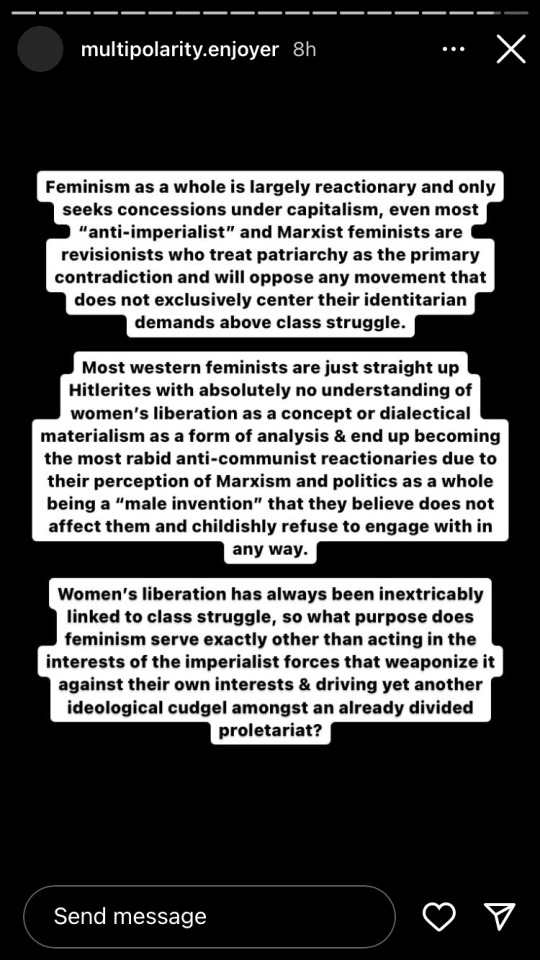
How dare feminists center women’s struggles and define male oppression from the root lol. Feminists too smol brained to understand dialectical materialism. Feminism is a device of division that should be stopped. Feminism is . . . uh . . . racist. Feminists don’t understand women’s liberation or class struggle. Even the Marxist feminists are just uh . . . revisionists because Marx and Engels were already pure and perfect feminists with pure and perfect analysis
Women whining about their oppression is dividing the proletariat. Women don’t deserve their own political party that centers them lmao? There’s uh, working class struggles we all have to fix first! Then women will be free! If we were all just commies and marxists and people just understood that capitalism and imperialism (male-created) were abolished, men would be nicer and normal to women and women’s issues would evaporate! Because that’s worked so well before! Obvi!
feminists women are so stupid and don’t understand anything
feminism has done nothing for actual people men
#radblr#feminism#marxfem#how are we feeling marxfems?#radical feminism#every man ever going “trust me bro we’re different I promise it will be different if you just gave us systemic power not all men bro”#“let me hold that feminism for you bro you’re not doing it right”#“fight for our cause first and then we’ll fight for yours you need us bro trust me bro we’ll definitely make women liberated”#“your fight is our fight bro just focus on us and you’ll see our win is your win”#“it’s not patriarchy that created the bourgeois it’s the bourgeois that created patriarchy I promise”#“women organizing themselves to ally specifically with women after being betrayed by men in every political movement is stupid bro”#“men are historically fair and just”#“men are not a political party lol what a crazy concept bro”
74 notes
·
View notes
Text
i’m all for slapping gay labels on greek gods for the funsies but i would love people to realize there’s a difference between “this god was asexual in everything but name” and “there’s no well known stories about this god fucking anyone”. absence of evidence is not evidence of absence.
#greek mythology#not to mention getting into the political and societal implications#athena not wanting to get married was abt her representing a powerful women being able to choose her own destiny#not NECESSARILY bc she was uniterested in sex at all#i actually groove with her as asexual but there is historical context
65 notes
·
View notes
Text
Sometimes I want to read genderbend fic because I want to see how things would realistically turn out if one or more characters were women instead of men - how relationship dynamics would change, how political situations would change (based on the setting), how much social issues would affect or not affect them.
Sometimes I want to read genderbend fic where everything is the same because I just want more women.
#my mood changes constantly. especially if it's a historical (ish) setting. like sometimes i'm curious how women (who were powerful#political figures as male characters) are treated or how they navigate canon situations as women. how much changes. yknow.#and then other times i'm like SCREW HISTORICAL ACCURACY. canon doesn't change. let me see a powerful woman in charge.#i'm saying stuff#gender bend#rule 63
19 notes
·
View notes
Text

💀 GIRL BYEEEE
#also I dont know how to tell y'all this. nuns be fucking.#nuns BEEN fucking. many such historical accounts. like genuinely.#sometimes innocuously. and sometimes they were very much predators. a lot like priests - when you#gather a bunch of individuals together who are both deeply sexually repressed and subjugated in#other aspects of their life - feel morally superior to others - isolate them - and then give them power over others (usually children) gues#what? there's going to be corruption and predatory behavior. I fucking hate this post because WHY ARE U ACTING LIKE#NUNS ARE THESE SWEET INNOCENT LITTLE HOLY WOMEN. NUNS ARE FUCKING ROTTED.#90% OF THE FAMILY ABUSE STORIES I'VE BEEN TOLD HAVE BEEN ABOUT NUNS. they dont need your protection yall
18 notes
·
View notes
Note
When do you think was the first time Esme went to University and how do you think it went for her?? 🥹
Thanks for this! @stregoni-benefici🥹💕❤️I LOVE this question!
Here are some of my thoughts:
I think Esme went to university as early as the 1930s for an art/art history degree. Although the official guide says Esme has degrees in architecture and art, I don't think the first one she got was an architecture degree. I do think one of the fandom's headcanons that the reason Esme wasn't working as a teacher was that she didn't want to risk her children's lives makes a lot of sense. Her caution made her choose to give up teaching art after decades of wrestling with the desire to drink blood, but she still loved art so she went to college to refine it. Even though the guide doesn't mention art history I think it opened up Esme's interest in ancient architecture (and of course the 17th century Carlisle) and decided to pursue ancient building restoration as a career. So immediately after earning a degree in art/art history, Esme chose to pursue another degree in architecture. And it makes perfect sense that she would earn these degrees in the 1930s. During the Great Depression, the New Deal funded and facilitated numerous archaeological expeditions and projects, including collecting folklife records and restoring early American architecture. Key agencies included the WPA, CCC and Historic American Buildings Survey.
I think Esme's college life was rewarding but difficult - not academically challenging, but in terms of being a woman in a misogynistic, elite institution. She faced stereotypes about her intellectual capabilities and discouragement from male professors, as well as strict rules and restrictions placed specifically on women's behaviour and coursework options. The university excluded women architecture students from mentorships and work/apprenticeship opportunities that developed technical skills. The university rarely allowed women students to take site visits or hands-on design assignments from conception to construction. She was steered only towards "suitable" decoration projects. She had to be careful of her reputation if attending sessions too late into the evenings or being the only female. So I think it's quite possible that during the same time period, Carlisle was also attending the university to do a degree/find a teaching job (New Moon does mention the tradition that Carlisle would return to the university from time to time), for Esme's sake, and also to be exposed to the latest research. Moreover, financial difficulties, theoretically should not be hard since her husband was rich, but I've always felt that for Esme her past of being controlled and abused made her value all aspects of freedom and independence (nothing personal about Carlisle, of course). Carlisle could give her lavish gifts, but it was her degree, her choice, and she would pay for it. Unfortunately, most scholarship funding and paid jobs went to male students at the time. She had to sell some of her paintings anonymously to pay for her tuition and she continued to confront immense sexism and lack of career opportunity postgraduation.
I feel college was an important milestone in Esme’s "humanization" process. Not only did she finally overcome her fear of slipping in the crowd, but she was finally able to achieve something as a woman, as herself. She didn't have to be anyone's mother or wife in order to survive with her head held high.
#stregoni-benefici#every time i see your ask in my inbox💕🥹#for my fellow historian and one of the most powerful women i know❤️#twilight#esme cullen#my headcanon#twilight historical context
27 notes
·
View notes
Text

Portrait of Renée Vivien by Otto Wegener circa. 1900
#1900s#early 20th century#historical costuming#historical fashion#renee vivien#women authors#directoire#can’t tell if she’s supposed to be a muscadin or incroyable#well… she’s got her executive power#directoire dress seems to be a common costume around this time#there’s photos of her girlfriend with her also dressed in directoire fashion. but I couldn’t find them in great quality
62 notes
·
View notes
Text
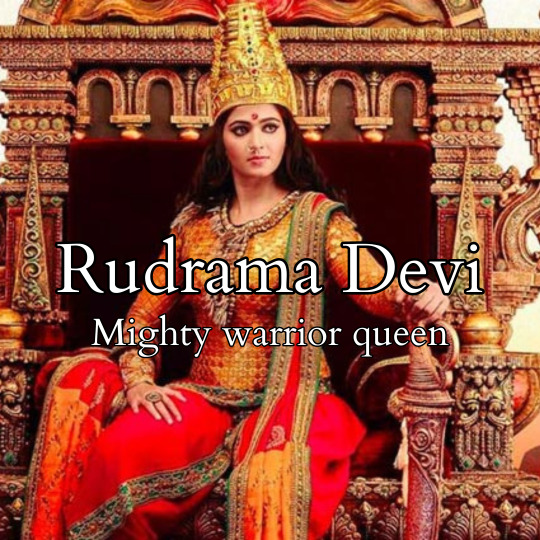
An unprecedented female monarch in her dynasty, Rudrama Devi (r.1262-1289) presided over an age of prosperity. A successful warrior queen, she triumphed over both internal and external threats.
Her father’s heir
Rudrama Devi was the daughter of King Ganapati Deva (r.1199-1262) of the Kakatiya dynasty, who ruled over parts of present-day Telangana and Andhra Pradesh in Southern India. Their capital was located at Orugallu (Warangal).
Ganapati Deva was a successful monarch. His kingdom was famed for its’ diamonds and beautiful fabrics. He had no son to succeed him and his older daughter was already married. He thus decided to make his younger daughter Rudrama Devi his heir and gave her the requisite training.
A female monarch would nonetheless be a in vulnerable position and see her legitimacy questioned. To make female rule more acceptable, he arranged a Putrikayagna ceremony for his daughter. This religious rite allowed a sonless man to declare his daughter or his daughter’s son as his son. After that, Rudrama Devi was also known by the masculine name of Rudra Deva. She also attended all public meetings in masculine attire.
Her story is similar in that regard to that of her near-contemporary, Raziya Sultan of Delhi.
A warrior among warriors
In 1259, Rudrama Devi became her father’s co-ruler and assumed sole rule in 1262. She married the Chalukya prince Virabdhadra, who played no part in her administration, and with whom she had three daughters.
Rudrama Devi faced many threats at once. Her neighbors saw an opportunity to conquer her kingdom and her feudatory noblemen couldn’t stand being ruled by a woman.
She stood her ground and prevailed, proving her might as a warrior queen. Many of her nobles rebelled, but she successfully defeated them. The Seuna Yadava king, Mahadeva, invaded her territories and reached her capital. Rudrama Devi chased him after 15 days of fighting and forced them to pay a heavy tribute in money and horses.
To commemorate her victory, she styled herself “Rayagajakesari” or “the lion who rules over the elephant kings”. In the pavilion she built, she was depicted as a warrior mounted on a lion, holding a sword and a shield, with an elephant trunk holding up a lotus to her in sign of submission.
In 1262, another of her neighbors occupied the Vengi region. She was able to recover it after 12 years of fighting. She was nonetheless unsuccessful in fending off the attacks of her southern rival Ambadeva.
Meritocratic policies
Rudrama Devi completed the construction of the nearly impregnable Warangal Fort. She bought large tracts of land under cultivation, increasing her kingdom’s revenue. She also recruited non-aristocratic warriors from diverse castes. Only 17 percent of her subordinates were of noble background. Prominent commanders could receive lands and become feudatory nobles. She thus established a new warrior class. Since the nobility had rejected her rule, this meritocratic policy allowed her to surround herself with loyal retainers.
Marco Polo, who mistook her for a widow of the previous king, wrote about her very flattering terms, calling her a “lady of much discretion” and a “lover of justice, of equity and of peace”.
A warrior to the end
At the end of her reign, she chose her grandson, Prataparudra, as her heir.
Rudrama Devi likely died in 1289 (though some sources date her death from 1295) according to an inscription made by a member of her army commemorating her recent death and that of her army chief. The cause and location of her death are unknown. She likely died facing Ambadeva's armies, leading her troops as she had always done.
Further reading
Gupta Archana Garodia, The women who ruled India, leaders, warriors, icons
Janchariman M., Perspectives in Indian History From the Origins to AD 1857
Talbot Cynthia, "Rudrama‐devi, Queen of Kakatiya dynasty (r. 1262–1289)", In: The Oxford Encyclopedia of Women in World History.
Talbot Cynthia, Precolonial India in Practice: Society, Region, and Identity in Medieval Andhra
#rudrama devi#13th century#history#women in history#women's history#historyedit#women's history month#india#indian history#queens#powerful women#women warriors#warrior women#historical figures#herstory
75 notes
·
View notes
Text
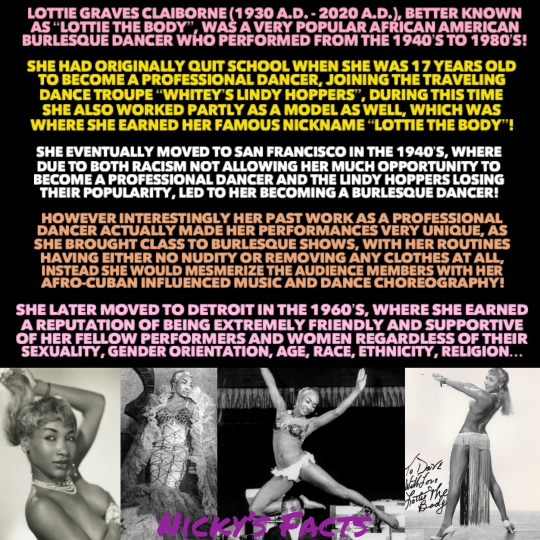
Lottie the Body brought class and acceptance to burlesque shows!
💃🏾
#history#lottie the body#burlesque#dancer#lottie graves claiborne#american history#detroit#black queen#burlesque performer#historical figures#black coquette#black history#black history month#role model#african american women#united states#girl power#black beauty#african american history#sisterhood#women supporting women#black tumblr#womens history#black girl magic#black excellence#soft black girl#women empowerment#nickys facts
75 notes
·
View notes
Text
580 years ago this day, Lady Margaret Beaufort "mother of Tudor dyatsy" was born.

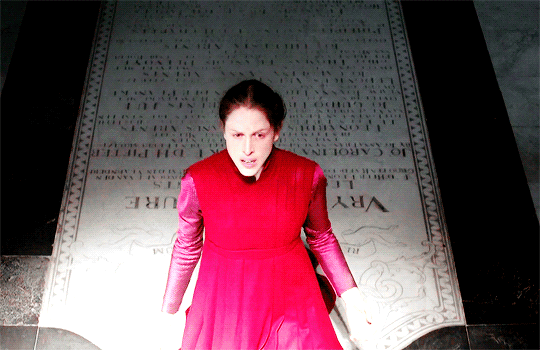


#margaret beaufort#history#historical drama#english history#historyedit#history of english#women in politics#women in power#women in history#medieval history#medieval women#15th century#the tudors#tudor era#tudor history#tudor dynasty#tudor england#tudors
50 notes
·
View notes
Text
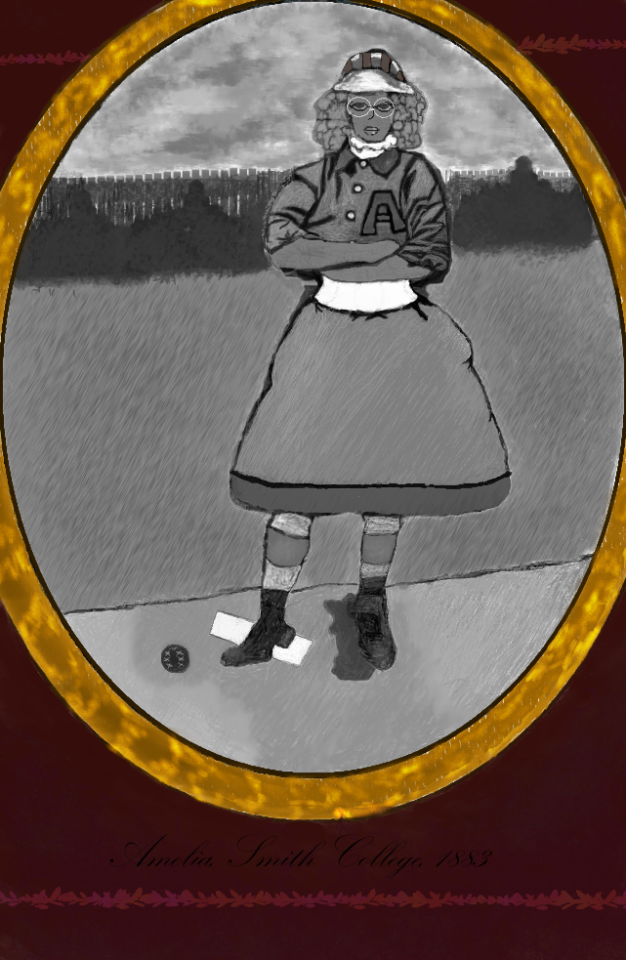
From the photo album of Lord Arthur Kirkland- Amelia, Smith College, 1883
Historical Note: In 1866, the first all women-baseball team was formed at Vassar College. While this first team, and the many that followed, never lasted long due to outside pressures related to fears that such "manly" activities would harm the female reproductive system, many unofficial teams began to pop-up at the women's college of the Eastern United States. One such team was formed at Smith College in 1883. For many of these early sport pioneers, the uniform consisted of wool dresses that went from either the ankle to just above the knee. Often teams would personalize them with embroidery and other design choices.
Color drawing and references under cut
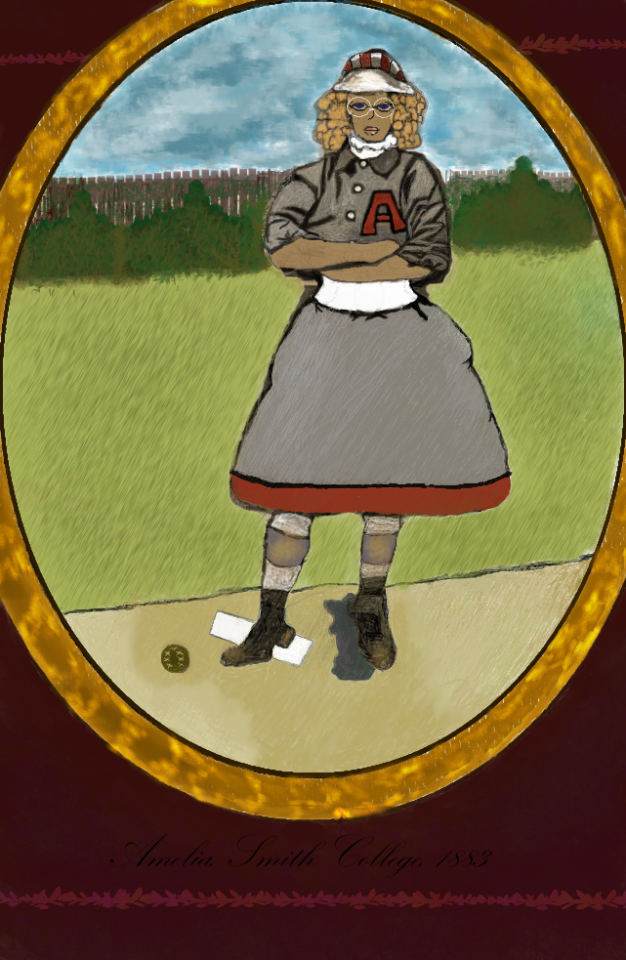
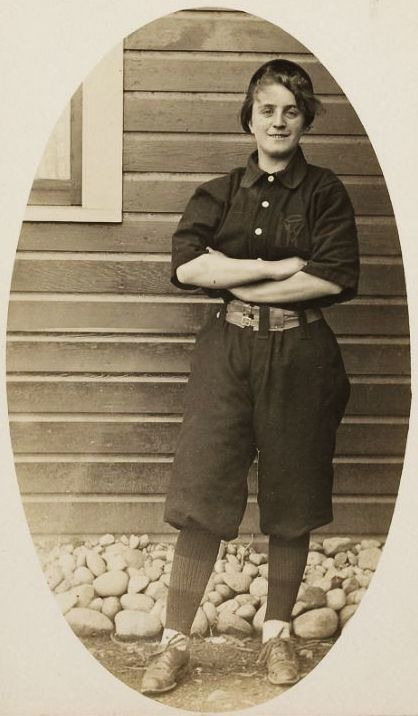
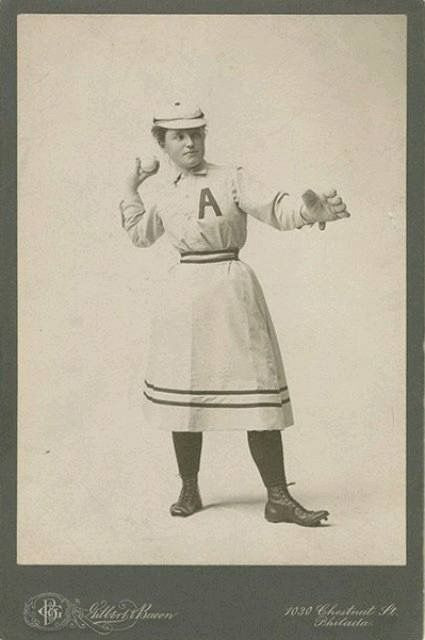
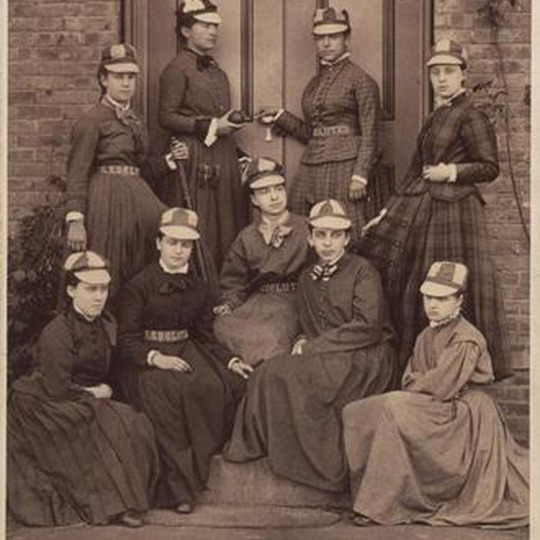
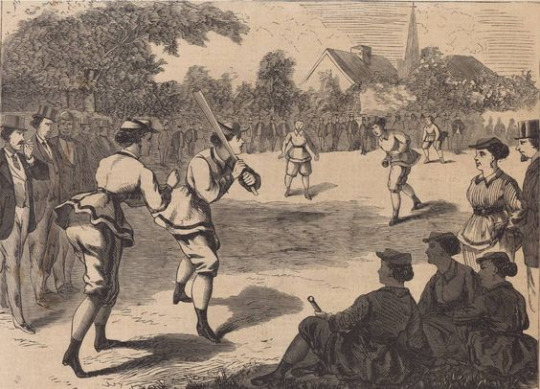
#imagine you just wanna play some ball and you gotta do it in thick wool dress and a high neck lace collar#was reading some neat academic journals about early womens baseball and its really interesting#a lot of social cultural and even economic factors involved. Like baseball being viewed as to “rough” for women is why tennis was pushed#for rich white women#things I still have to work on: Not using references so closely#hair and eyes#nyo america#amelia jones#hws england#face family#aph america#hws america#nyotalia#nyo amelia jones#historical hetalia#give Amelia glasses 2024#Alfred: Batter#Amelia: Pitcher#hetalia#hetalia world powers#my art#hetalia fanart#hws#aph#hetalia world stars#idk I really feel proud of this#it is far from good or perfect but I put a lot of work into this and idk pretty happy#you can decide if the A stands for America#Amelia#the team name
15 notes
·
View notes
Text
i wonder if labour-based organising is lionised a little too much in leftist spaces.
#things venus said#like outside of ideological concerns... unions have been reactionary forces at the same time they have been liberatory for some#the iww historically consolidated white labour power at the expense of black workers#the sag-aftra strike has ended with people in hollywood no more free to express their opposition to genocide#and to speak of reproductive labour there have been multiple movements based on the idea that women can consolidate their labour-power#that have simply fallen flat in no time
9 notes
·
View notes